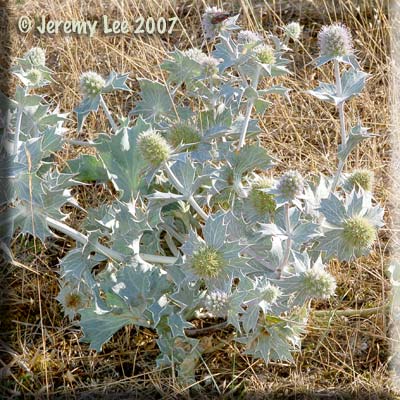
 |
|
Scientific Classifications explained » Amphibians » Ants » Aphids » Bees » Beetles » Birds » Bugs » Butterflies » Caterpillars » Damselflies » Dragonflies » Earwigs » Flies » Frog/Leafhoppers » Fungi » Galls » Grasshoppers » Harvestmen » Hoverflies » Lacewings » Ladybirds » Leaf Mines » Lichens » Mammals » Millipedes » Mosses » Moths » Sawflies » Slugs » Snails » Spiders » Trees » Wasps » Wild Flowers » Woodlice |
UK Nature > Wild Flowers > Blue & Purple Wild Flowers > Eryngium maritimum

Scientific Name: Echium vulgare Common Name: Sea Holly Although more closely related to the carrot than holly, Eryngium maritimum, more commonly known as Sea Holly, is instantly recognisable by its pale, bluish-green, holly-like leaves with their tough, waxy covering that looks like they are iced - arming it against the harsh coastal conditions it lives in. The attractive round heads of powder-blue flowers, usually seen between July and September, are further shielded by substantial spiny bracts. Height is up to c60cm. The flowers and foliage have made it a popular architectural plant in gardens with sandy, dry soil, although it is becoming increasingly scarce in the wild; it only grows around the coastline of the UK and is almost absent from Scotland and the north-east of England. |
|

https://www.uknature.co.uk is a website dedicated to showing the immense diversity of UK nature and wildlife. Our vast range of habitats, from lowland arable to snow covered mountains, from storm-ravaged coastlines to peaceful inland freshwater lakes and rivers, from dry, sandy heaths to deciduous and coniferous forests, all these habitats contribute to the abundance of UK nature. We have wild birds in huge numbers either residing or visiting our shores (597 recorded species as at July 2013) and we must also not forget the humble back garden with its grass lawns, flower beds filled with nectar rich flowers, shrubs and trees, all designed to attract huge numbers of insects such as bees, moths, butterflies and hoverflies; and finally the small ponds which provide safe havens for frogs, toads, newts and even slow worms and grass snakes. www.uknature.co.uk is the showcase for my personal passion, photographing uknature in all its glory. I sincerely hope you all enjoy the fruits of my labours. This site and all images contained therein is © Jeremy Lee 2004 - 2021. All Rights Reserved. Site design by Jeremy Lee. Site development & IT Support by Stuart Lee. |